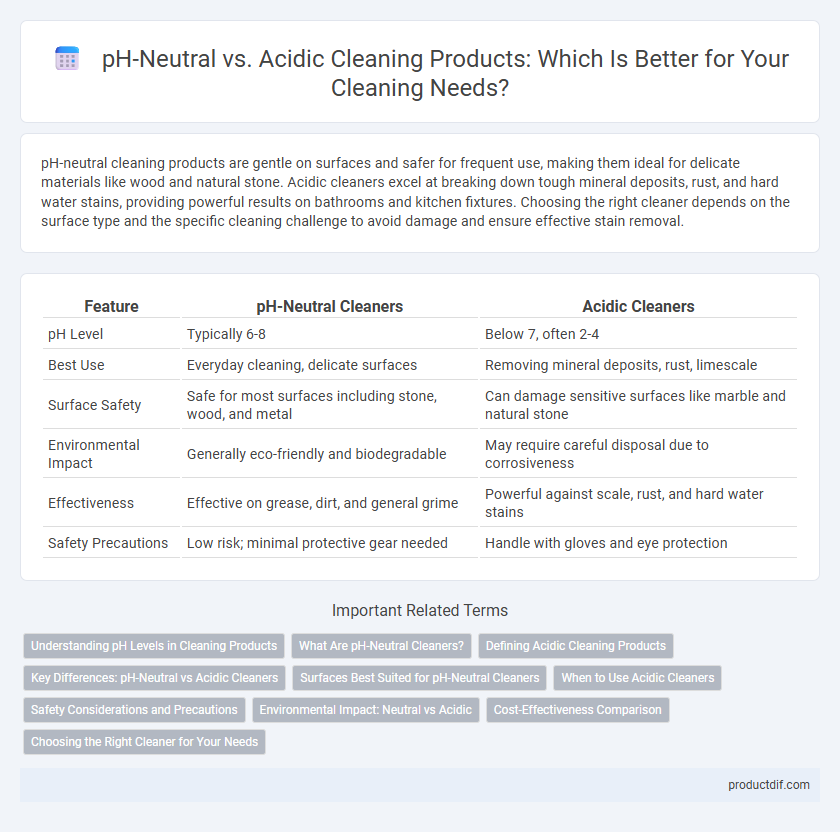pH-neutral cleaning products are gentle on surfaces and safer for frequent use, making them ideal for delicate materials like wood and natural stone. Acidic cleaners excel at breaking down tough mineral deposits, rust, and hard water stains, providing powerful results on bathrooms and kitchen fixtures. Choosing the right cleaner depends on the surface type and the specific cleaning challenge to avoid damage and ensure effective stain removal.
Table of Comparison
| Feature | pH-Neutral Cleaners | Acidic Cleaners |
|---|---|---|
| pH Level | Typically 6-8 | Below 7, often 2-4 |
| Best Use | Everyday cleaning, delicate surfaces | Removing mineral deposits, rust, limescale |
| Surface Safety | Safe for most surfaces including stone, wood, and metal | Can damage sensitive surfaces like marble and natural stone |
| Environmental Impact | Generally eco-friendly and biodegradable | May require careful disposal due to corrosiveness |
| Effectiveness | Effective on grease, dirt, and general grime | Powerful against scale, rust, and hard water stains |
| Safety Precautions | Low risk; minimal protective gear needed | Handle with gloves and eye protection |
Understanding pH Levels in Cleaning Products
Understanding pH levels in cleaning products is crucial for selecting the right solution for different surfaces and stains. pH-neutral cleaners, typically with a value around 7, are gentle and safe for most materials, preventing damage and preserving finishes. Acidic cleaners, with pH values below 7, are effective at dissolving mineral deposits, rust, and hard water stains but should be used cautiously to avoid corrosion or surface etching.
What Are pH-Neutral Cleaners?
pH-neutral cleaners have a balanced pH level around 7, making them gentle on surfaces and safe for regular use on materials like wood, laminate, and natural stone. Unlike acidic cleaners that typically have a pH below 7 and are effective at removing mineral deposits and rust, pH-neutral products effectively clean dirt and grime without causing surface damage or corrosion. These cleaners are ideal for sensitive surfaces and environments where maintaining safe chemical exposure is important.
Defining Acidic Cleaning Products
Acidic cleaning products contain a low pH, typically below 7, making them effective for dissolving mineral deposits, rust, and hard water stains. These cleaners often include ingredients like hydrochloric acid, sulfamic acid, or citric acid to break down tough grime on surfaces such as tiles, toilets, and metal fixtures. Unlike pH-neutral products, acidic cleaners require careful handling to avoid surface damage or skin irritation.
Key Differences: pH-Neutral vs Acidic Cleaners
pH-neutral cleaners have a balanced pH around 7, making them gentle on surfaces and ideal for everyday use without causing damage or discoloration. Acidic cleaners possess a low pH, typically below 7, and are effective at removing mineral deposits, rust, and hard water stains but can be harsh on sensitive materials. Choosing between pH-neutral and acidic cleaners depends on the type of surface and the nature of the cleaning task, balancing efficacy and surface safety.
Surfaces Best Suited for pH-Neutral Cleaners
pH-neutral cleaners are ideal for delicate surfaces such as natural stone, hardwood floors, and painted walls, as they prevent damage and preserve finish integrity. These cleaners maintain the surface's natural balance without causing corrosion or discoloration, unlike acidic alternatives which can etch or dull sensitive materials. Using pH-neutral solutions enhances longevity and appearance for surfaces prone to erosion or chemical sensitivity.
When to Use Acidic Cleaners
Acidic cleaners are most effective for removing mineral deposits, rust stains, and hard water buildup on surfaces like tile, porcelain, and metal. These cleaners typically have a pH below 7, which helps dissolve calcium carbonate and other alkaline residues that neutral or basic cleaners struggle to remove. Use acidic products cautiously on delicate materials, as their low pH can cause etching or corrosion if misapplied.
Safety Considerations and Precautions
pH-neutral cleaning products are generally safer for frequent use, reducing the risk of skin irritation and respiratory issues, making them ideal for households with children and pets. Acidic cleaners, while effective at removing mineral deposits and rust, require careful handling; users should wear gloves and ensure proper ventilation to avoid chemical burns and inhalation hazards. Always read labels and follow manufacturer guidelines to prevent accidents and ensure safe use of both pH-neutral and acidic cleaning agents.
Environmental Impact: Neutral vs Acidic
pH-neutral cleaning products minimize environmental harm by maintaining balanced chemical properties that prevent soil and water acidity disruption, reducing risks to aquatic ecosystems and beneficial microorganisms. Acidic cleaners, while effective for certain stains, can contribute to soil acidification and water pollution, negatively affecting biodiversity and requiring cautious disposal methods. Choosing pH-neutral solutions supports eco-friendly cleaning practices, preserving natural habitats and promoting long-term environmental sustainability.
Cost-Effectiveness Comparison
pH-neutral cleaning products typically offer cost-effectiveness through their versatility and reduced risk of surface damage, minimizing the need for repairs or replacements. Acidic cleaners, while often more potent on mineral deposits and tough stains, may require frequent use of protective measures and surface restoration, increasing overall expenses. Choosing pH-neutral solutions can lower long-term costs by combining safe, effective cleaning with extended material lifespan.
Choosing the Right Cleaner for Your Needs
Selecting the appropriate cleaning product depends on surface sensitivity and soil type; pH-neutral cleaners maintain a balanced pH around 7, making them ideal for delicate surfaces such as wood, laminate, and sealed stone by preventing damage or discoloration. Acidic cleaners with a pH below 7 effectively dissolve mineral deposits, rust, and soap scum, making them suitable for bathrooms, tiles, and hard water stains. Understanding the pH level ensures optimal cleaning performance while protecting surfaces and prolonging their lifespan.
pH-neutral vs Acidic Infographic

 productdif.com
productdif.com